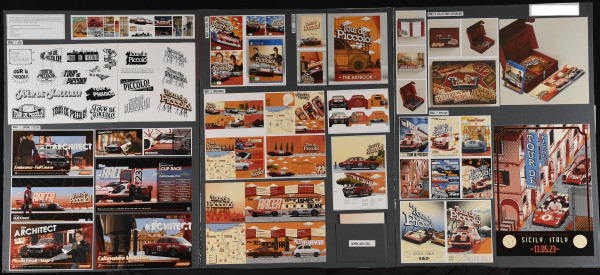2024 Outstanding Scholarship
Social Scape is an exemplary example of an Outstanding Scholarship Design brief and
communicates a clear provocation of a real-life issue addressing the subject of
misinformation informed by the candidate’s personal experience and perspective. A duality
of personal knowledge and data-driven research informs a visual investigation that
contextualises ideas and utilises tactics such as humour and persona to develop characters
that connect to the audience. All design outcomes fluidly integrate and inform the next phase
of working, which culminates in a final format pertinent to addressing the consequences and
complexities of this topic in a social context.
The workbook substantiates ideas, articulating relevance and importance of educating and
informing young people around the dangers of the use of AI and online platforms within
digital media. In parallel, consideration for the target audience demonstrates an ability to
think laterally with strategies and the decision to produce a board game, places analogue
processes at the heart of the design solution. The candidate has combined context and
media that challenges the conventions of digital online media and employs a user-centred
framework to educate the audience. In the workbook, characters are personalised and given
anthropomorphic features that are used to communicate key messages within the campaign.
Expressions and personality are highly considered and tested with the target audience to
understand user functionality and experience. The colour palette is thoughtfully considered
and underpinned by knowledge of colour theory to reflect personality traits relevant to
message and for young people to understand.
This investigative mode of enquiry is sustained holistically across the folio and annotations in
the workbook and reveals high levels of research, critical thinking, and analysis of the topic.
The communication has been used effectively through new strap lines, catchphrases, names,
and information that can be read with clarity. The final game play interaction brings together
a range of devices that sits within the conventions of gameboard design to create a
sophisticated and engaging outcome.
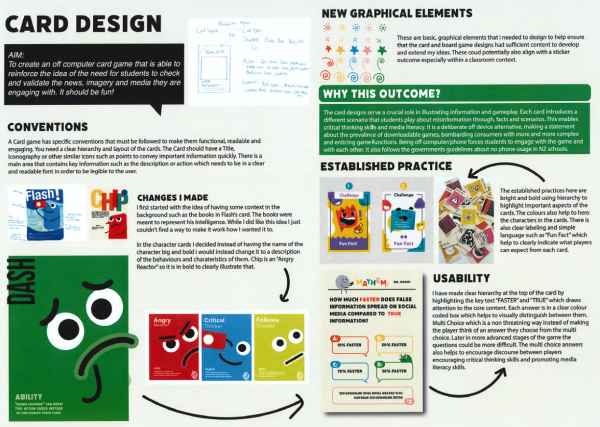
Download 2024 Outstanding Scholarship Design workbook [PDF, 3.2 MB]
On this page
2024 Scholarship
The Scholarship submission Cataclysm Films establishes a design brief aimed to promote an
animated film set in an apocalyptic world. There is clarity of thinking in the brief to ensure
that constraints and parameters foster a linear process that is underpinned by critical
evaluation and decision-making. This is a solid example of Scholarship rewarded for its
foundational focus on research and ability to resource and invent ideas that communicate a
coherent and appealing narrative and theme. The workbook outlines clear and logical
development and annotates to evaluate the development and regeneration of ideas. The
editing and inclusion of research into the target audience, statistics, symbolism, and key
messages in the workbook delves into the topic and affords a breadth of resources to draw
upon that sustain the enquiry. The workbook is used to drive the investigation, which
translates to the working designs on the folio with clear intentions, explicit communication,
and synthesis of a personal design style. The design process employs design strategies to
advance ideas communicated through a range of collateral – poster design, ticket, website,
and double-page spreads. It is evident that the design process is critically managed through
the buoyant range of ideas, the decisions in creating characters, and the integration of ideas
fuelled by phases of research.
Ideas are consolidated by a command of graphic design and storytelling conventions. The
candidate confidently employs media and technical skills to execute options and construct
links between phases of work. There is a sophisticated understanding of the relationship
between typography and image, with an ability to construct and transition towards new
solutions. The candidate has analysed the functionality of design frameworks that operate
within and between formats, capitalising on tropes to independently position their own
graphic treatment and style. Illustration and image-making pay homage to the conventions
employed in graphic novels and animation, enhancing communication, and are coupled with
typographic messaging, headings, subheadings, and body copy to also enhance audience
experience.
Storytelling is central to the brief and this submission understood the context and methods
required to communicate and craft a final resolution within each phase of work, ensuring high
productional values of design.
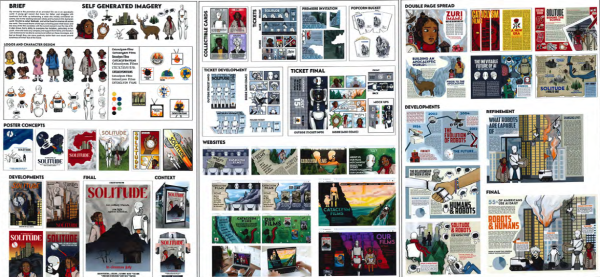
2023 Outstanding Scholarship
This Outstanding Scholarship Design illustration-based submission required the candidate to “design the graphic identity and promotional material” for the children’s storybook Olive Goes Into Orbit. Drawing on their personal experience of being neurodivergent and having a passion for aerospace engineering, the candidate developed an original storyline to unpack a parallel story through Olive, who also has OCD and lives in a world filled with worries, fears, and everyday struggles. Like the candidate, Olive has a companion in Cooper, the dog, to help her through. The briefs include event ID, book launch brochure, double-page spreads, a book nook (accompanying 3D model), a book cover, and posters for the book release.
An overarching modality of visual metaphors is employed throughout and cleverly utilised to communicate information, emotion, and ways of seeing. The candidate researched conventions thoroughly, providing a solid basis for intelligent experimentation and decision-making. They considered how they can draw readers into the story so they feel comfortable and reassured about the content. Editing decisions were made by understanding designs in situ and being open to change. Sketching out ideas played an integral part in the typography ideation and, similarly, in the generation of imagery. Photographs taken of hand actions and their dog were then transferred into character designs, maintaining a sense of authenticity. Stock imagery is converted into simplified line drawings that became compositional backgrounds for the storyline.
The story arc utilised conventions that relate situationally to the candidate’s personal journey. The workbook includes an analysis of Olive’s everyday life, along with storyboarding, that leads the reader through the trials and tribulations of the character’s journey to the moon. The delight of discovering the visual metaphors in all the briefs makes this submission conceptually and critically inventive. The details beautifully communicate emotion and a determined attitude: Olive’s half-filled glasses when she gets overwhelmed, her startled eyes, and her quivering mouth. This is matched by the dual narration of personal information about Olive: her dislike of olives, skipping cracks in pavements, and lying dreaming amongst the daisy typeface. Likewise, building empathy with the reader is achieved compositionally through scale changes to suggest vulnerability, bird’s-eye view, proximity, and isolation within the picture frame.
A strength of this submission is the candidate’s research into the design conventions of the media and formats utilised. The interactive aspects of the fold-out circular brochure and the bespoke book nook bring this proposition to life. You can imagine Olive Goes Into Orbit in a children’s bookshop along with all of the merchandise developed by the candidate for this submission, including future ideas.
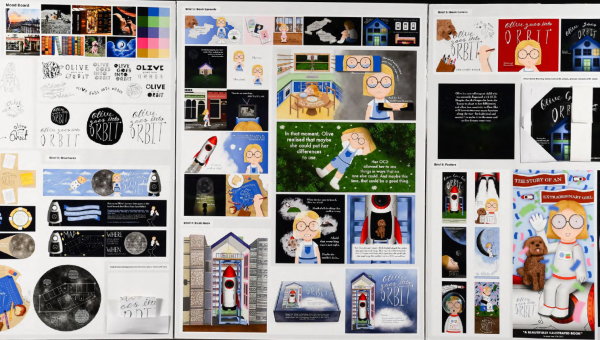
Download 2023's Outstanding Scholarship Design exemplar [PDF, 6.2 MB]
2023 Scholarship
This Scholarship Design submission settled on creating an advertising campaign for the brand Oceano, exploring the effects of sunscreens on the environment and the impacts of chemical spills into oceans. The workbook documents the journey towards finding a topic of personal interest that focuses on environmental concerns, preservation, and care surrounding coral reefs and marine life.
In critically considering a range of possibilities that sat in real-world contexts, the candidate was able to identify a flexible and generative set of briefs. The campaign includes a logo, floating keychain, poster, recyclable plastic sunscreen bottle, 3D information booklet, and an interactive exhibition space – all of which are contextually well-handled. For example, the 3D information booklet (included as a concertina fold-out on the folio) has a tactile quality, achieved through topographic map-like layers and cut-outs, raised relief captions, and interactive flaps (information windows).
There is a strong sense of the candidate’s hand in the making, which inserts a sense of personal conviction along with the informative text (copy writing) and visualisation. Materials were chosen to make products conceptually relate to the brand – the floating keyring is made from cork and buoyant material. This environmentally friendly attitude is present throughout the entire enquiry with the generation and use of motifs, typography, colour, and scale contributing to the fun and interactive elements and overarching tone the candidate wanted to impart. Issue-appropriate questions were asked when developing the collateral for the various self-designed briefs by utilising well-researched data and existing companies and brands on the market.
Solutions to problems posed are dealt with through strong material exploration and hands-on making. The workbook shares the successes and failures of the candidate’s working with plastics and resources aligned to the topic and the point where innovation and potential design solutions came to the fore. The workbook analyses ‘how’ ideas could be put into action through problem-solving feasibility and the practicalities of repurposing materials into forms, such as making the sunscreen bottle through heat processes. An experimental approach is employed throughout the folio work, with the candidate taking their own photographs to recognise visual qualities that link media to the ocean, such as the aesthetic of the melted plastic.
The candidate engaged with briefs that operate at different scales and require design-appropriate ambitions. They met these through constant attention towards the potential reception of each outcome and having a sharp focus on the knowledge and experience they wanted to communicate to a learning public, including the purpose and functionality of the various design propositions.
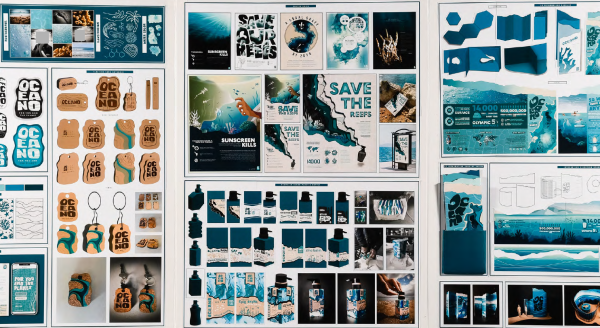
2022 Outstanding Scholarship
This Outstanding Scholarship submission is a moving image. Titled Grafted Grifters, it is based on the negative impacts of ‘gifted-kid syndrome’. It is an animated, action-adventure television series set at Arc Academy in Deco City about genetically modified, gifted children.
Three central characters are developed – Bea, Frankie, and Oli. They have no interest in meeting parental expectations and, instead, moonlight as criminals using their unique and special gifts to stage heists.
The target audience is young teens, and the storyline and pace of the enquiry are well-matched by the retro-future and cyberpunk aesthetics utilised.
Instigating a tight set of conditions and parameters ensured this submission could travel widely. The candidate clearly enjoyed making this work. Each element of the design process is rendered in line with the provocation: masthead, character design, environment design and the animated intro. They develop and recognise how stereotypical character traits create depth to the visual storytelling, for example: “Oli’s love for robotics and computers; Bea’s super strength and general airheaded-ness; and Frankie’s cleanliness, love for strategy games, and overachieving nature.” All of these personalities, designed by the candidate, are authentic and convincing.
The workbook is insightful, analytical, reflective, and searching. The candidate selects conceptually-relevant and media-appropriate animation and television contexts to identify and position their perspective on the subject.
A broad range of contemporary/retro, popular culture television series, films, and animation is analysed, including Big Bang Theory, and Never Have I Ever, to pull out stereotypical behaviours for their gifted trio. The candidate draws on personal experience and some characters they designed in middle school, revamping them to explore how gifted young people combat assumptions, and the societal problems and negative ramifications of the label.
Technically, the candidate has excellent facility. The masthead runs through various typographic explorations, accounting for print and animation, and extends through animated glitch sequences and sound effects. Character development is sophisticated and clever, and embeds the voracity of Oli, Bea and Frankie through analysis of attitudinal traits, colour, body shape, and character accessories to advance communication (school, criminal, weapon).
The soundtracks employed (electro swing) align closely with the transitions of the moving image, and the storytelling, timing and movement within the animated introduction. Details like the treatment of line and fill, light and shadow, and colour treatment all contribute beautifully to this exemplary and highly-finessed scholarship submission.
Download 2022 Outstanding Scholarship Design workbook pages [PDF, 34 MB]
2022 Scholarship
This Scholarship submission, Tour de Piccolo!, focuses on the candidate's interest in cars and video games; the final proposition is a video game based on endurance racing events like the Targa Florio (Sicily, 1906–1973). Fuelled by the candidate's passion for cars, car models, and races, alongside studying the Italian Renaissance in Art History, they embarked on creating the video game collateral (fonts and typography, event ID, illustration style, posters, loading screens, brochures).
The enquiry was set up well, and the brief and proposition are very clear. The consistency of design elements is a decisive factor; the employment of typography is exploratory, and operates within design conventions. Thorough research underpins the mood set, and the 1970's aesthetic which is their own without over-reliance on found sources, ensures ownership of the genre.
Shifts are made between sub-briefs that develop the brand and add to the range of project images. They consistently revisit compositions, viewpoints, and layouts to communicate the message. This thorough approach is reinforced by the well-documented workbook, demonstrating the candidate's level of interest and engagement. The workbook functions as a process to test, challenge, and experiment with ideas and possibilities, rather than past-tense journaling.
The graphic material for each collateral piece has been well-researched and treated in a new but connected design format. For example, the brochure uses die cuts, and looks at various ways to fold, etc. The posters challenge the types of shapes, compositions, and imagery that suits a poster format. Colour is a hero component with different temperature and saturation values exploited to complement the nature of individual briefs, and differences between the digital screen and printed image.
Overall, the candidate is invested and engaged with the topic, which helps keep the exploration moving forward. The communication is clear for the target audience and uses appropriate visual language to match the speed and excitement of the race event. The extensions proposed in the workbook make sense in the context of the proposition: the game HUD (heads-up display), a point-of-sale stand, and a sales tent. These successfully fit within the declared parameters and associate collateral required of Tour de Piccolo!
